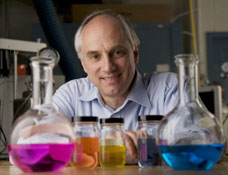Artificial plants are called to grow all over the United States
Each synthetic tree can remove carbon emissions and other harmful gases by thousands of times the natural tree. In the emissions reduction campaign that the US pledged, inventor Klaus Lackner recently met with Energy Secretary Steven Chu to ask him to propose President Obama to deploy the planting of this tree throughout the United States.

Professor Klaus Lackner
(Photo: popscience)
African and Australian Baobab trees are an important part of Africa's unique forests. It is thought that many trees have lived for thousands of years because the tree has no growth circle to rely on to determine age. With its giant body, this plant suitable for limestone is a grandmaster to clean the air from harmful gases. But how many trees have to be planted and how many years do they have to wait for them to work?
Trees are natural ' devices ' that absorb carbon dioxide from the atmosphere and means to prevent climate change . That's why people often pay attention to big trees, leaves a lot to do this. But Professor Klaus Lackner, Columbia University (USA), thinks differently. He does not plant but ' build ' the tree - but the synthetic plastic tree. He made plastic plants and tested them: they absorb carbon dioxide 1,000 times faster than natural plants.
' Trees ' with plastic leaf sets can attract and ' confine ' carbon dioxide in their ' cells ', compressing them into liquids. The tree does not draw air through direct sunlight from the sun like ordinary trees that hold the gas in the enclosed spaces of the leaves (actually a large CO 2 absorber), which can be removed, transportation to recovery locations for use (but usually handled on the spot).
Inventor Lackner says absorbing CO2 can be converted into jet fuel and cars, which are the two largest sources of emissions. If not, it is used to improve crop yields.

Baobab tree (Photo: Flickrs)
Klaus Lackner, a professor at Columbia University, who is still finalizing the synthetic trees, met with Energy Secretary Steven Chu last month to present his proposal. In an interview with CNN Television, he said synthetic plants recover carbon emissions that can be converted into better energy than wind generators hundreds of times. For every 1,000kg of carbon dioxide recovered, the tree only discharges 200kg. This rate is enough to compensate for the high cost of plants (equivalent to a car) or to invest in the exhaust treatment equipment of coal-fired thermal power plants.
Each synthetic tree can recover 90,000 tons of carbon emissions and generate 3MW of electricity a year.
- Why do twins and triplets increase suddenly?
- Pine tree is nearly 5,000 years old
- Metamorphosis of plants
- Hospitals in the United States are about to have emergency robot nurses
- The United States allows the use of artificial intelligence to diagnose diseases
- The broad and serious impact of air pollution in the United States
- Artificial molecules enhance immunity against HIV virus
- Plants can hear sounds when they are eaten
- The 'enemy' of the pyramid is about to show up
- Tornadoes make dozens of casualties in the United States
- Plants also recognize 'peach blood'
- Female voice helps plants grow fast
 Why do potatoes have eyes?
Why do potatoes have eyes? 'Tragedy' the world's largest carnivorous life: Death becomes ... public toilet
'Tragedy' the world's largest carnivorous life: Death becomes ... public toilet Tomatoes were once considered 'poisonous' for 200 years
Tomatoes were once considered 'poisonous' for 200 years Detecting microscopic parasites on human face
Detecting microscopic parasites on human face